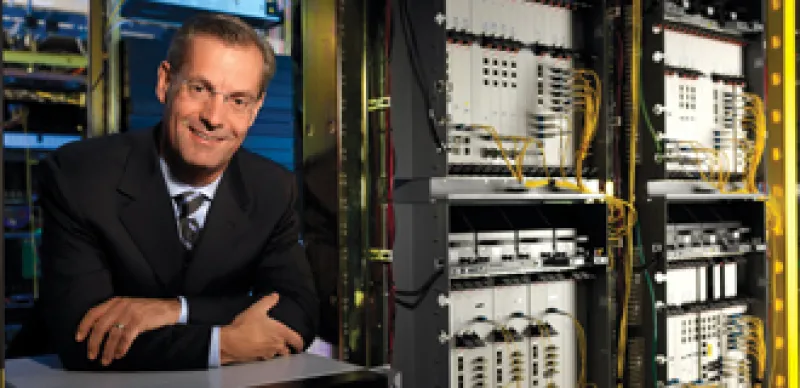Ciena Corp. doesn’t provide cement for highways or steel for bridges, yet it is arguably in an even more vital infrastructure business: providing optical networking equipment, along with software and services, to support voice, video and data traffic around the world.
Based in Linthicum, Maryland, Nasdaq-listed Ciena (market cap: $2.6 billion) caters to about 1,000 customers, from communications carriers to cable operators to governments and private companies. A year ago it acquired the optical networking and carrier Ethernet assets of bankrupt Nortel Networks’ Metro Ethernet Networks (MEN) for $774 million, doubling Ciena’s size and expanding its domain by 40 countries, to 60. Ciena’s sales in fiscal 2010 (ended October 31) reached $1.2 billion. Its stock price, meanwhile, is up about 90 percent in the 12 months through mid-February.
The Nortel initiative belongs to Gary Smith, CEO and president of Ciena since May 2001. An MBA graduate of Britain’s Ashridge Management College, Smith, now 50, joined Ciena as vice president of international sales in 1997 after serving as a senior sales and marketing executive at Intelsat, a global satellite communications company.
A member of President Obama’s National Security Telecommunications Advisory Committee, Smith also sits on the Global Information Infrastructure Commission, a group of telecom industry executives dedicated to fostering a beneficial information society. He is involved in the Center for Corporate Innovation, a professional services organization that provides forums for CEOs and other senior corporate officers to discuss critical business issues.
Who better to talk about the ongoing global communications revolution? Smith recently spoke with Senior Contributing Editor Firth Calhoun.
Institutional Investor: Data consumption is exploding. How is your industry keeping up?
Gary Smith: We’re the circulatory system, if you will, for the broad Internet, including mobile. But it’s not just a question of putting more capacity out there. It’s also about building smarter networks so you can optimize that capacity.
How so?
Think about two axes. One is geographic reach, which encompasses more and more people around the world. The second axis is applications. The difficult thing for us all to comprehend is that we’re only at the early stages.
What role is Ciena playing?
Networks around the world were all designed and built to bring terrestrial [land-line] phones to your house and business. But they’ve done a pretty good job of adapting to this thing called the Internet and to video and mobile. What Ciena has been focused on is enabling these large carriers to transform their networks to increase their capacity and do it at a lower cost. It’s about economics as much as technology.
Where is your best opportunity?
We’re different from our more generalist competitors [such as Alcatel-Lucent, Ericsson, Huawei Technologies Co. and Nokia Siemens Networks] in being a focused player. So we need to be more innovative and to have very intimate relationships with our customers, built around their networks. The real opportunity for us is to enable the scaling up of bandwidth while driving down the economics so that our customers can make money.
You operate in 60 countries. Where are the best prospects — Asia?
Well, we’ve still got a long way to go in North America in terms of applications, smart networks and cloud computing. All will continue to generate enormous amounts of growth on the network. If you look at Europe, it’s similar. And we’ve got Eastern Europe and the Middle East building real infrastructure for the first time in some countries: huge opportunities! Latin America, similarly.
What about China?
China is very challenging from a market point of view. It’s difficult to make money. State capitalism makes China somewhat challenging.
What’s Ciena’s biggest challenge?
We did, by anybody’s perspective, a transformational merger [with Nortel’s MEN] in March 2009, and we’re very mindful that M&A activities don’t have a great history. But we’re making great progress, though we’re not declaring victory yet. We’re still operating on two back-office systems, for example. But integration has gone extremely well around products, platforms, technology and people. Customers have been very supportive. My sense is that people are becoming confident of our ability to execute on the merger.
What does today’s technological upheaval mean for the computer user in a cubicle?
You’ve right now got this confluence of factors — technology, maturing business models, favorable economics — underpinning enormous change. It is a very exciting time. For the individual, there are going to be a lot more options.
Such as?
Well, one dimension is mobility. We’re used to having our computer at our desk and keeping data right there on our hard drive. With cloud computing, data will be all around and accessible at any time. And the devices to access it are going to change. IPads and other tablet-type devices afford enormous mobility. So you’re going to see movement away from the static desktop-type computer.
Beyond that?
Video will play an increasing part in people’s interactions. You can have pretty good teleconferencing now from a laptop or a tablet. Multiple applications at affordable price points will provide more and more access to information. And this next generation of mobile phones is the first where people will feel comfortable enough, and have enough speed, to truly surf the net. Clearly, all of this will bring structural changes to businesses and to the way people live.
What if plugged-in employees decide to scatter every which way?
Well, how do you manage that? How do you keep people truly connected, not just from a network perspective but from a cultural and societal point of view? How do you keep the cohesion of the business?
Is that the only big task for managers?
The other major issue is turning a whole lot of data into knowledge. The amount of data that is going to come at us is just enormous. How do you filter what’s relevant? I suspect that over the next few years a lot of work will be done in this field because as human beings we just can’t absorb all that data in a rational way.
How do you cope at Ciena?
I have to say the cobbler’s unshod son is always the worst off, but we’re working on it. As part of the integration, we’re upgrading our network. That sounds a little obvious, but we’ve neglected it. So we’re introducing desktop video, and I think it’s going to be huge interactively. Sending out e-mails doesn’t equal cohesion. I personally think there is no substitute for human contact as well.
Is it wise for tech companies to hold off going public?
There are times when being private is helpful, because you can’t deliver to investors in a way that’s easily communicated, and you’ve got high risk in terms of the evolution of your technology and value proposition. The ability to deliver neatly packaged, predictable quarterly results to meet Street investors’ very short-term aspirations makes for a challenging dynamic for tech companies, with their long investment cycles. Some companies should always stay private. But the benefits of being public on the whole outweigh the drawbacks.
Why is that?
There are a lot of advantages, and not just the access to money. It provides great discipline. It provides transparency and protection to investors. In fact, there are huge benefits to capitalism, and the U.S. system is second to none in generating and supporting innovative ideas. It’s taken a lot of bashing over the past few years, but we need to recognize what we’ve got and try to nurture that system.
Tech is generating investor excitement again. Are we in a bubble?
That’s a good question. I’ve lived through a couple and have the scars to prove it. But certainly from an Internet-video-mobile perspective, we’re in a much better place. First of all, business models have matured. People are making money on the Internet. Second, the technology has enabled much greater access to a broad market — much better price points. The economics are better. We have a much more healthy ecosystem.






